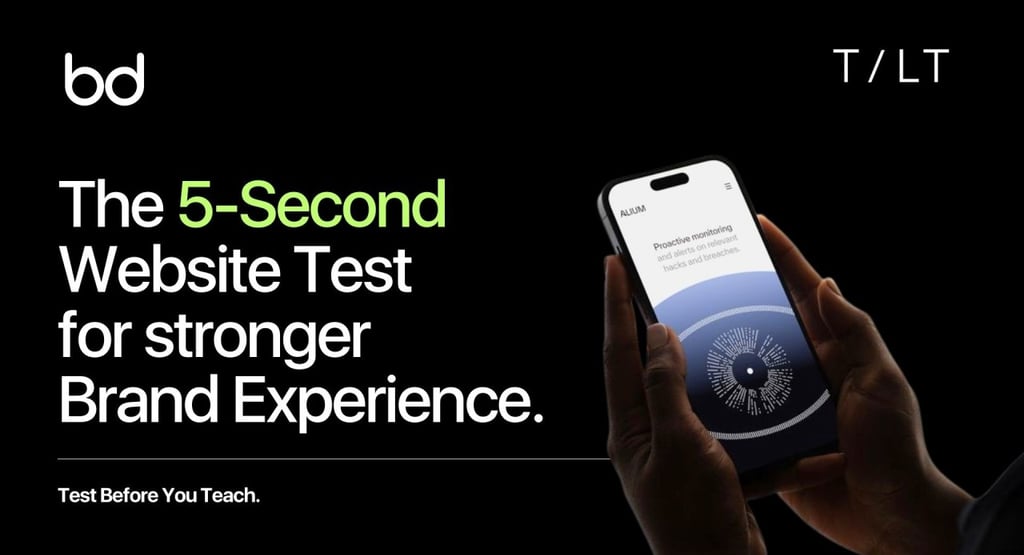The 5-Second Website Test: Would Your Brand Survive It?
In today’s digital-first world, your website isn’t just a digital brochure; it’s the front door to your brand. And in most cases, visitors don’t give you minutes to make a first impression. They give you seconds.
Brand Blinks Global
3 min read


In today’s digital-first world, your website isn’t just a digital brochure; it’s the front door to your brand. And in most cases, visitors don’t give you minutes to make a first impression. They give you seconds.
In fact, research by Google shows it takes just 50 milliseconds (0.05 seconds) for users to form an opinion about your website’s design. That’s faster than the blink of an eye. But here’s the catch: while people may “sense” design in milliseconds, it’s the first 5 seconds of interaction that determine if they’ll stay or leave.
This is where the 5-Second Test comes in.
What Exactly Is the 5-Second Test?
The 5-second website test is simple:
Show your homepage (or landing page) to someone for 5 seconds.
Take it away.
Now ask them:
What was the page about?
What do you remember most?
Would you trust this brand?
What action would you take next?
If your site passes, you’re in the clear. If not, you’ve got work to do.
Why 5 seconds?
Because in those early moments, users decide:
Clarity: Do I understand what this brand offers?
Credibility: Does it look professional and trustworthy?
Relevance: Is this for me?
Direction: Do I know what to do next?
Miss one of these, and you’ve lost the chance to convert.
Data That Proves the Stakes Are High
88% of users are less likely to return to a website after a bad experience
75% of users judge a brand’s credibility based on website design alone
Even 1-second delays in load time can reduce conversions by 7%
So yes, those first seconds directly translate into revenue gained or lost.
A Famous Example
When Airbnb redesigned its website in 2014, its goal wasn’t just aesthetics. In user testing, they found people couldn’t articulate what Airbnb offered at first glance. The messaging was fragmented.
After simplifying visuals, clarifying the headline (“Belong Anywhere”), and making the booking journey obvious, Airbnb saw a significant lift in engagement and trust metrics.
Their 5-second impression went from “a listings site” to “a global community where anyone can belong.”
Red Flags Your Website Might Fail the Test
Your homepage is cluttered with too many CTAs.
Stock photos that feel generic and don’t reflect your brand.
Headlines that talk about you but not the value for the customer.
Inconsistent fonts, colours, or brand voice.
Load times that drag beyond 3 seconds.
If visitors can’t recall what you do or why it matters within 5 seconds, they’ll bounce, often straight to a competitor. Many businesses fail the test because they look at it only as a design problem. But in reality, it’s a strategic challenge best tackled with expert branding consulting.
How to Improve Your 5-Second Impression
Start with a Clear Value Proposition
In one line, explain what you do and why it matters.
Example: Slack → “Slack is your digital HQ.” Short, memorable, relevant.
Design for Scanning, Not Reading
Most people don’t read; they scan. Use bold headlines, whitespace, and clear CTAs. Clarity in the first 5 seconds isn’t only about visuals; sometimes, friction lies in navigation. Running a ux audit can reveal usability barriers that cost you conversions.
Visual Consistency = Trust
Align colours, fonts, and imagery with your brand identity. A mismatch erodes credibility instantly. Your brand visuals, colours, typography, imagery, all shape trust in those first moments. Inconsistency signals confusion; consistency signals credibility.
Prioritize Speed
Compress images, optimise code, and test load times. Slow = exit.
Test, Don’t Assume
Run 5-second tests with unbiased users (not your internal team). Gather feedback, spot gaps, iterate.
Why This Matters for Growth
Passing the 5-second test isn’t just design polish; it ties back to your brand strategy and development, ensuring your positioning and promise shine through immediately.
Think of it this way: marketing can drive traffic to your site, but if the first 5 seconds fail, you’re paying for clicks that never convert.
What You Can Do Next
Run a 5-second test on your homepage this week.
Ask customers (not colleagues) to describe what your site stands for after a glance.
Compare responses with your brand strategy. Do they align? If not, it’s time for a recalibration through a brand audit to uncover gaps in perception and positioning.
If not, it’s time for a recalibration.
At Brand Blinks Global, we help brands pass not just the 5-second test, but the long-term test of relevance, clarity, and trust. Because scaling doesn’t start with more ads, it starts with a sharper brand experience.





© 2025 BRNDXMORPH Media Worldwide Private Limited. All rights reserved
Brand Blinks Global® | BBG is an independent global brand consulting and transformation company.
The trademarks, logos, and service marks displayed on this site are the property of their respective owners.
"Brand Blinks Global®," "Brand Blinks®," "Made for the Uncommon®," and the "bd®" logo are trademarks or registered trademarks of BRNDXMORPH Media Worldwide Private Limited.
RESOURCES
INTELLIGENCE
BUSINESS
PARTNER
COVERAGE
EXPLORE
Made for the Uncommon®


When your brand grows, others rise too. 2% of your project empowers a nonprofit we back together every year.


